When deciding between digital and analog cameras, it’s essential to consider the specific advantages each offers for different photography styles. Digital cameras excel in urban settings with their instant feedback and editing capabilities, while analog cameras shine in landscape photography, providing a unique aesthetic and dynamic range. Understanding these strengths can help you choose the right tool for your creative vision.
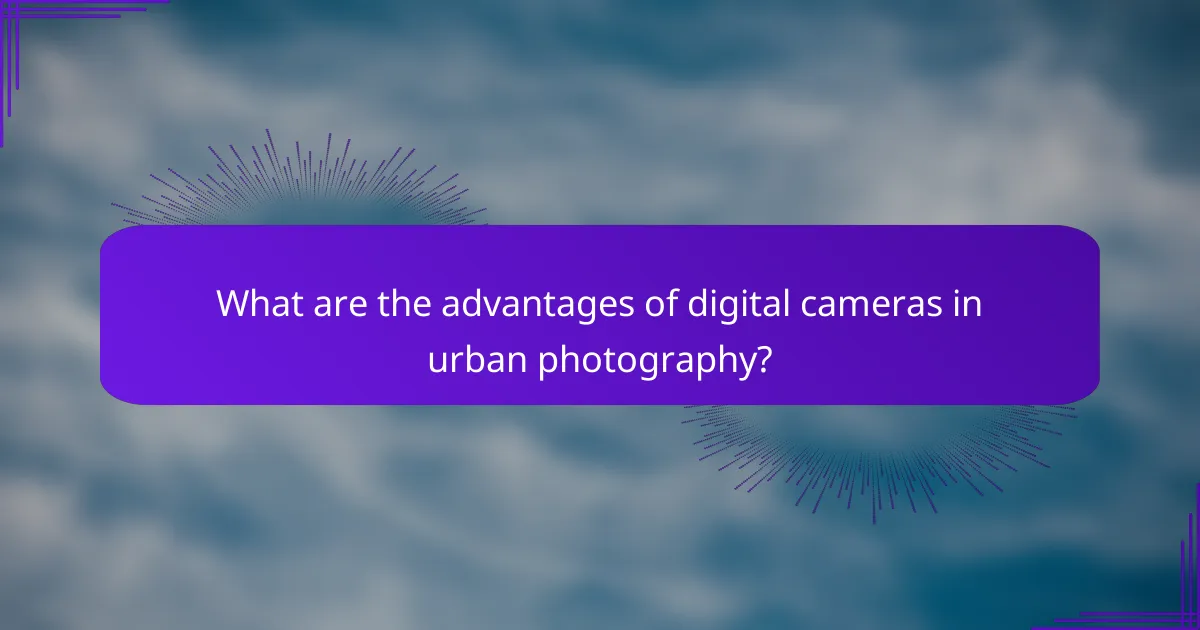
What are the advantages of digital cameras in urban photography?
Digital cameras offer several advantages in urban photography, including instant feedback, superior low-light performance, and extensive editing capabilities. These features make them particularly well-suited for capturing the dynamic and often unpredictable nature of urban environments.
Instant image review
One of the key benefits of digital cameras is the ability to instantly review images after capturing them. This feature allows photographers to quickly assess composition, exposure, and focus, enabling immediate adjustments for better results. In fast-paced urban settings, this can be crucial for capturing fleeting moments.
Additionally, many digital cameras allow for the use of histograms and other tools to evaluate image quality on the spot. This immediate feedback loop helps photographers refine their skills and make informed decisions about their shots.
Higher ISO performance
Digital cameras generally excel in high ISO performance, which is essential for urban photography, especially at night or in low-light conditions. Many modern digital cameras can handle ISO settings in the low thousands without significant noise, allowing for clearer images in challenging lighting situations.
This capability means photographers can shoot in darker environments, such as alleyways or during twilight, without sacrificing image quality. It opens up creative possibilities that may be difficult to achieve with analog cameras, which often struggle with grain at higher ISO levels.
Versatile editing options
Digital images can be easily edited using a variety of software tools, providing photographers with the flexibility to enhance their work post-capture. Adjustments to exposure, color balance, and cropping can be made quickly and efficiently, allowing for a polished final product that reflects the photographer’s vision.
Moreover, the non-destructive nature of digital editing means that original files remain intact, offering the freedom to experiment without the risk of losing the original image quality. This versatility is particularly beneficial in urban photography, where lighting and conditions can change rapidly.
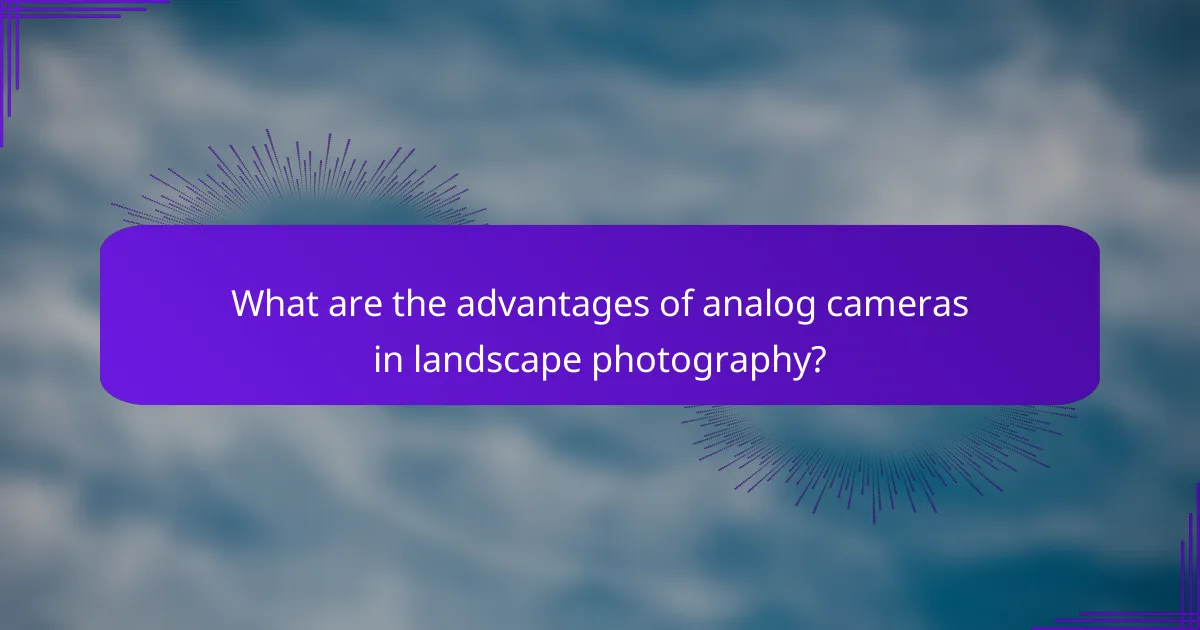
What are the advantages of analog cameras in landscape photography?
Analog cameras offer distinct advantages in landscape photography, particularly through their unique film characteristics, greater dynamic range, and timeless aesthetic appeal. These features can enhance the quality and emotional impact of landscape images, making them a preferred choice for many photographers.
Unique film characteristics
Analog cameras utilize film that captures light in a way that often results in richer colors and finer details compared to digital sensors. The grain of the film can add a unique texture, which many photographers find appealing for landscape shots. Different film types, such as color negative or slide film, can produce varying effects, allowing for creative choices based on the desired outcome.
When selecting film, consider factors like ISO rating and color balance. For instance, lower ISO films (e.g., ISO 100) are ideal for bright conditions, while higher ISO films (e.g., ISO 400 or above) can be used in lower light, albeit with increased grain. Understanding these characteristics can help you choose the right film for your landscape photography needs.
Greater dynamic range
Analog cameras typically have a greater dynamic range than their digital counterparts, allowing them to capture more detail in both highlights and shadows. This is particularly beneficial in landscape photography, where scenes often contain a wide range of light intensities, from bright skies to dark foregrounds. The ability to preserve detail in these extremes can lead to more balanced and visually appealing images.
To take advantage of this dynamic range, consider using techniques such as bracketing exposures or choosing the right time of day for shooting, like during golden hour. These practices can help maximize the potential of your analog camera in capturing stunning landscapes.
Timeless aesthetic appeal
The aesthetic quality of analog photography is often described as timeless, with a warmth and depth that many photographers and viewers appreciate. The subtle imperfections inherent in film, such as grain and color shifts, contribute to a nostalgic feel that can enhance the emotional resonance of landscape images.
When aiming for a specific look, consider experimenting with different film stocks and processing techniques. For example, cross-processing slide film in chemicals intended for negative film can yield unexpected and striking results. Embracing these unique qualities can help you create landscapes that stand out and evoke a strong sense of place.
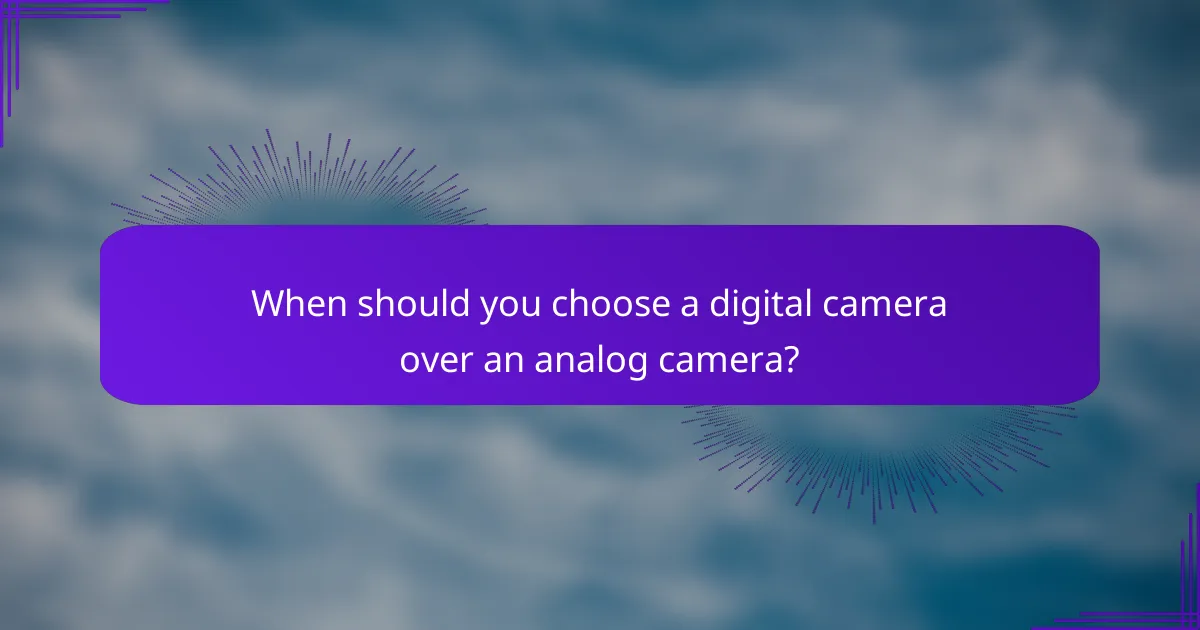
When should you choose a digital camera over an analog camera?
You should choose a digital camera over an analog camera when you need quick results, flexibility in editing, and ease of use. Digital cameras are ideal for various situations, especially where speed and convenience are priorities.
For fast-paced events
Digital cameras excel in fast-paced environments like sports events or concerts. Their ability to capture images instantly allows photographers to take multiple shots in quick succession, ensuring they don’t miss critical moments.
With features like burst mode, digital cameras can take several frames per second, which is essential for capturing action shots. This capability is often a significant advantage over analog cameras, which require time to advance film and may miss fleeting opportunities.
When budget is a concern
If you’re on a tight budget, digital cameras can be more economical in the long run. While the initial investment may vary, digital photography eliminates the recurring costs of film and development, making it more affordable for regular use.
Additionally, many digital cameras offer a range of options from entry-level to professional models, allowing you to choose one that fits your financial situation. Consider looking for used or refurbished models to save even more.
For convenience and portability
Digital cameras are generally more convenient and portable than analog cameras. They are often lighter and more compact, making them easier to carry around for everyday use or travel.
Moreover, digital cameras allow for immediate viewing and sharing of images, which enhances the overall experience. You can quickly transfer photos to your computer or mobile device, making it simple to edit and share your work online.
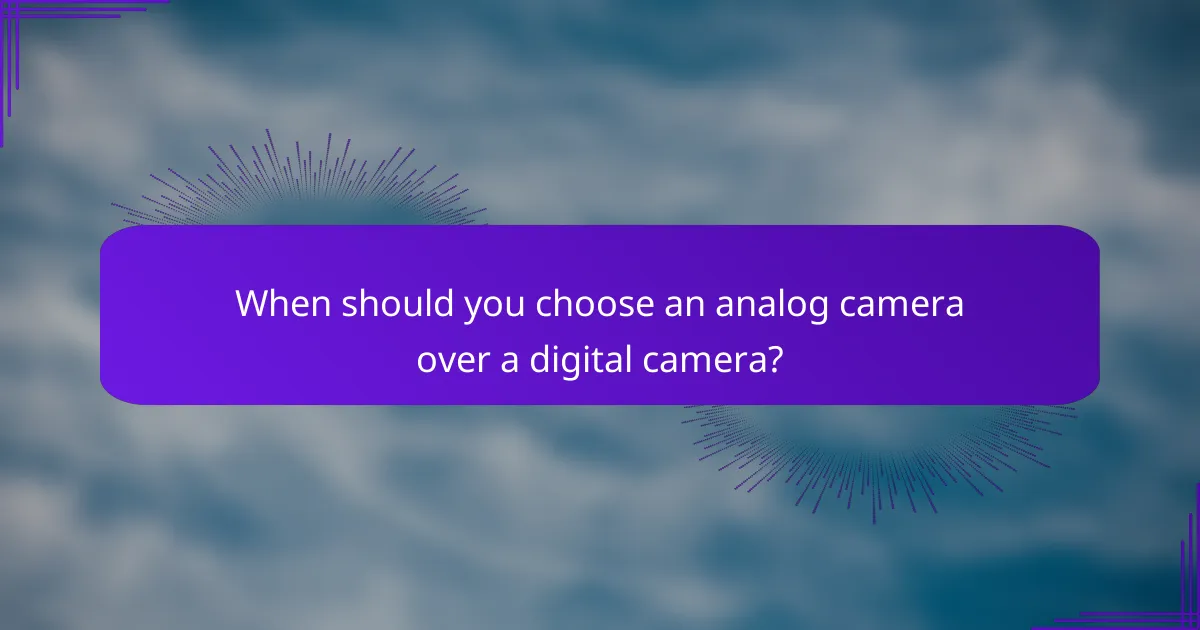
When should you choose an analog camera over a digital camera?
Choosing an analog camera over a digital one is ideal when you seek a unique aesthetic, prefer the tactile experience of film, or want to engage with photography in a more deliberate manner. Analog cameras excel in specific artistic and nostalgic contexts, making them a valuable choice for certain situations.
For artistic expression
Analog cameras often produce images with distinct characteristics, such as grain and color rendition, that many photographers find appealing. The limitations of film can encourage creativity, pushing photographers to consider composition and lighting more carefully before taking a shot. This deliberate approach can lead to more meaningful and impactful images.
Moreover, different film types can yield various results, allowing photographers to experiment with textures and tones that digital cameras may struggle to replicate. For artists looking to convey a specific mood or style, analog photography can be a powerful medium.
When shooting in controlled environments
Using an analog camera in controlled environments, such as studios or during planned shoots, can yield excellent results. These settings allow photographers to manage lighting and composition effectively, making it easier to take advantage of the unique qualities of film. For instance, using a tripod and controlled lighting can enhance the depth and detail captured on film.
Additionally, in controlled environments, the slower process of shooting with film can be beneficial. It encourages careful consideration of each shot, which can lead to more thoughtful and composed images. This is particularly useful in portrait or product photography, where precision is key.
For nostalgia and film enthusiasts
Analog cameras hold a special place for nostalgia and film enthusiasts, offering a tangible connection to the history of photography. Many people appreciate the ritual of loading film, developing prints, and the anticipation of waiting to see the final images. This process can be deeply satisfying and rewarding.
Film enthusiasts often enjoy the community surrounding analog photography, including film swaps, darkroom workshops, and exhibitions. Engaging with this community can enhance the overall experience and provide valuable insights into techniques and styles that are unique to film photography.
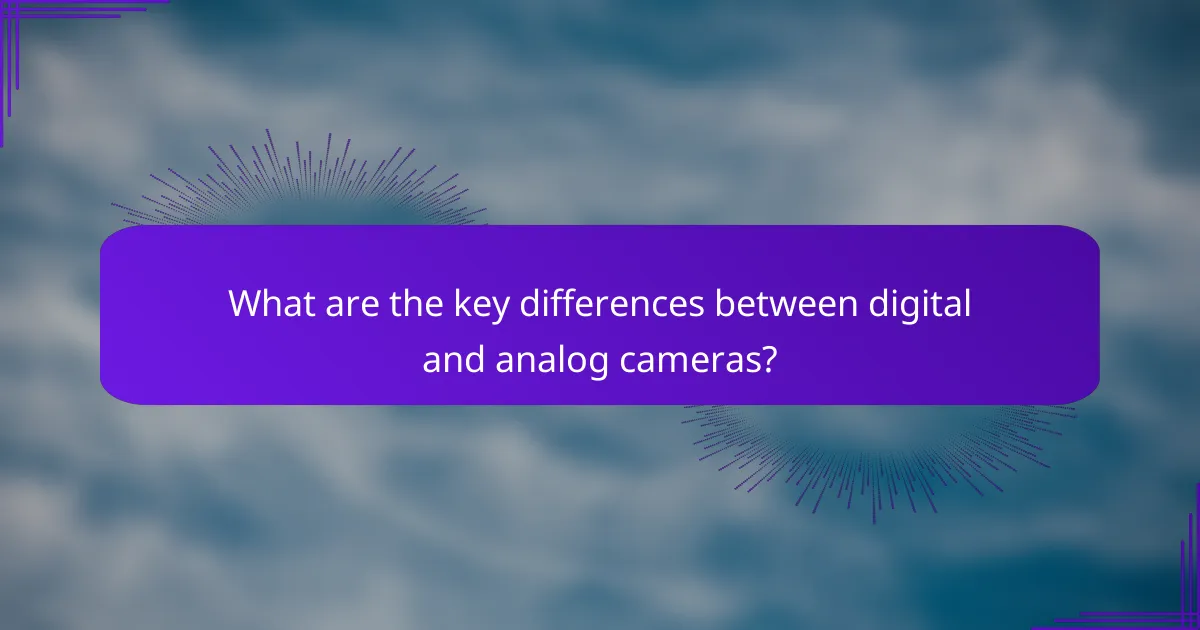
What are the key differences between digital and analog cameras?
The key differences between digital and analog cameras lie in their image capture technology, cost of operation, and post-processing requirements. Digital cameras use electronic sensors to capture images, while analog cameras rely on film. Each type has its own advantages and disadvantages depending on the user’s needs and preferences.
Image capture technology
Digital cameras utilize image sensors, such as CCD or CMOS, to convert light into electronic signals. This allows for immediate viewing and editing of photos. In contrast, analog cameras capture images on light-sensitive film, which requires development in a darkroom or lab before the photos can be viewed.
When choosing between the two, consider the immediacy of digital photography versus the traditional aesthetic of film. Digital cameras can offer features like higher ISO ranges and faster shutter speeds, while analog cameras may produce unique grain and color characteristics that some photographers prefer.
Cost of operation
The cost of operating digital cameras generally includes the initial purchase price, memory cards, and potential software for editing. In contrast, analog cameras incur ongoing expenses for film, development, and printing. While digital photography can be more cost-effective in the long run, initial investments in high-quality digital gear can be substantial.
For budget-conscious photographers, consider the frequency of use. If you shoot often, digital may save money over time. However, if you shoot infrequently, the costs of film and development for analog might be manageable.
Post-processing requirements
Digital images can be easily edited using software like Adobe Photoshop or Lightroom, allowing for significant adjustments in exposure, color, and composition. This flexibility is a major advantage for those who want to enhance their photos after capture. Analog images, however, require physical development and scanning for digital use, which can be time-consuming and costly.
When deciding on post-processing, think about your workflow. If you prefer quick edits and sharing online, digital is the way to go. If you enjoy the process of developing film and appreciate the tactile nature of prints, analog may suit you better.
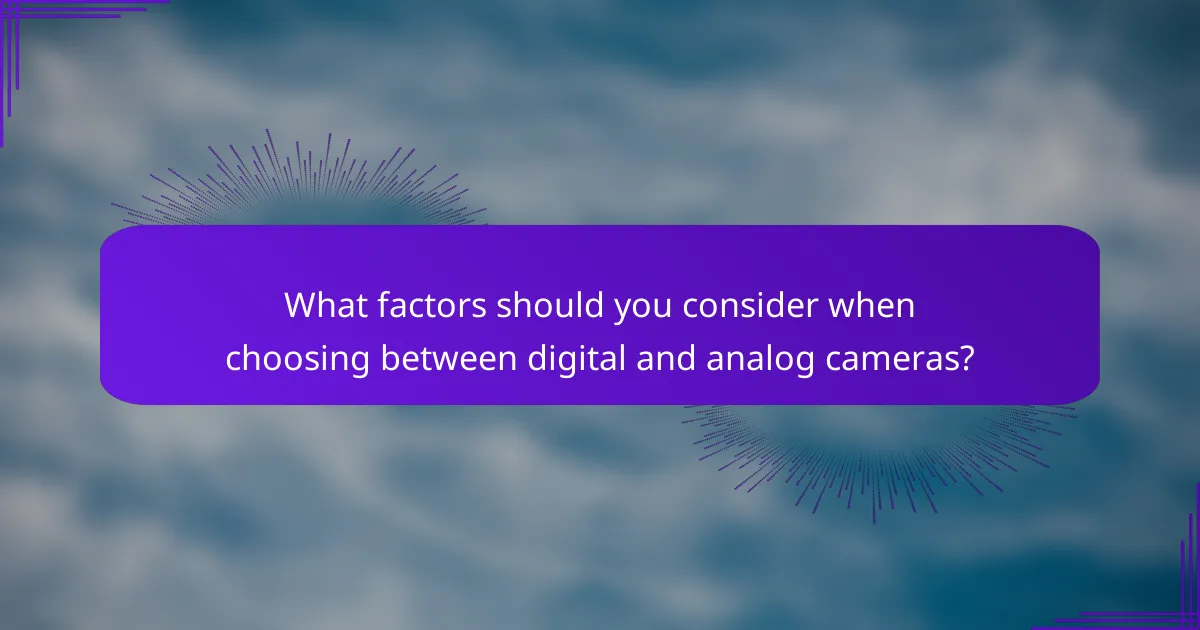
What factors should you consider when choosing between digital and analog cameras?
When choosing between digital and analog cameras, consider factors such as your photography style, budget, and intended use. Each type has unique advantages and limitations that can affect your decision.
Photography style
Your photography style significantly influences the choice between digital and analog cameras. If you prefer spontaneity and immediate results, digital cameras are ideal due to their instant feedback and editing capabilities. Conversely, if you enjoy the process of photography and appreciate the tactile experience, analog cameras may be more appealing.
For example, digital photography suits fast-paced environments like events or wildlife, where capturing moments quickly is essential. Analog photography, on the other hand, often encourages a more deliberate approach, making it suitable for artistic projects or portraiture where composition is key.
Budget considerations
Budget plays a crucial role in selecting between digital and analog cameras. Digital cameras can range from affordable point-and-shoots to high-end DSLRs, with prices varying widely based on features and brand. Analog cameras, while often cheaper upfront, require ongoing costs for film and development, which can add up over time.
When budgeting, consider not only the initial purchase price but also the long-term expenses associated with each type. For instance, a mid-range digital camera might have a higher initial cost but could be more economical in the long run due to the lack of film costs.
Intended use
Your intended use for the camera should guide your decision. If you plan to share images online or print large formats, a digital camera’s high resolution and editing flexibility are advantageous. Analog cameras can produce stunning images with a unique aesthetic, but they may require more effort to digitize for sharing.
For professional work, digital cameras are often preferred due to their versatility and efficiency. However, for personal projects or artistic endeavors, analog cameras can offer a distinctive look that many photographers cherish. Consider what you want to achieve with your photography to make the best choice.



